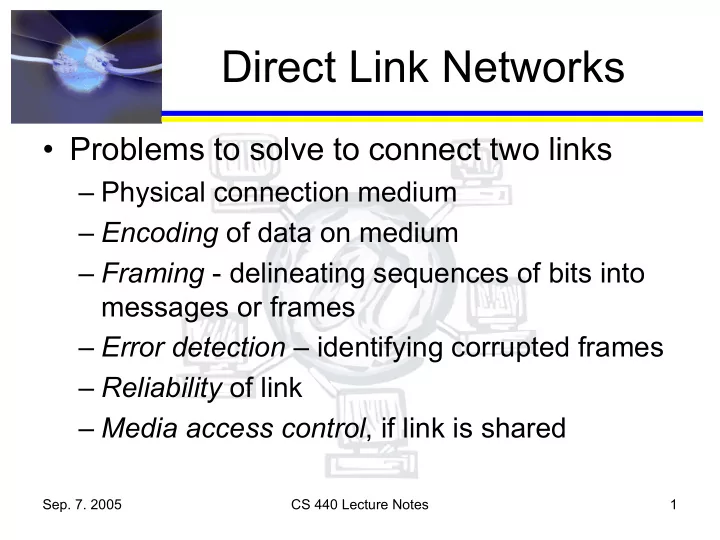

Direct Link Networks • Problems to solve to connect two links – Physical connection medium – Encoding of data on medium – Framing - delineating sequences of bits into messages or frames – Error detection – identifying corrupted frames – Reliability of link – Media access control , if link is shared Sep. 7. 2005 CS 440 Lecture Notes 1
Building Blocks • Networks are composed of nodes and links • Node: workstation, PC, switch, router – Typically includes a processor, memory, an I/O bus, and a network adapter – The network adapter is connection to the link – A software device driver controls the adapter – Processing is typically limited by memory size and speed, so memory efficiency is very important – Special nodes called Interface Message Processors (IMPs) were used in the original ARPANET – see http://www.livinginternet.com/i/ii_imp.htm Sep. 7. 2005 CS 440 Lecture Notes 2
Building Blocks (cont.) • Links – Different physical media: twisted pair (that’s the “T” in “10Base-T”), coaxial cable, optical fiber, space – Media used to propagating electromagnetic waves that carry the data signal – EM waves have frequency f and wavelength λ ; speed of wave c = f λ . Sep. 7. 2005 CS 440 Lecture Notes 3
Building Blocks (cont.) – Need to encode binary data onto signal • Modulate signal’s frequency, amplitude, and/or phase to somehow represent “0” and “1” • Links can be differentiated by number of bit streams that are supported simultaneously – Half-duplex : signal travels in only one direction at a time – Full-duplex : signals can travel in both directions simultaneously Sep. 7. 2005 CS 440 Lecture Notes 4
More on Physical Media • Link types – Cable • Cat-5 10-100Mbps 100 m • Thin-net coax 10-100 Mbps 200 m • Thick-net coax 10-100 Mbps 500 m • Multimode fiber 100 Mbps 2 km • Single-mode fiber 100-2400 Mbps 40 km – Cat-5 is the standard for within-building wiring; try to use this for new standards like Gigabit Ethernet Sep. 7. 2005 CS 440 Lecture Notes 5
Physical Media (cont.) • Leased Lines – DS1 / T1 1.544 Mbps – DS3 / T3 44.736 Mbps – STS-1 51.840 Mbps – STS- N N * STS-1 • T1 bandwidth represents 24 digital voice circuits of 64 kbps each; T3 is 28 T1s. Sep. 7. 2005 CS 440 Lecture Notes 6
Physical Media (cont.) • Last-Mile Links – POTS 28.8-56 Kbps (Plain Old Telephone Service) – ISDN 64-128 Kbps (Integrated Services Digital Network) – xDSL 16Kbps – 55.2 Mbps (Asymetric/Symmetric Digital Subscriber Line) – CATV 20-40 Mbps (Cable Television) Sep. 7. 2005 CS 440 Lecture Notes 7
Physical Media (cont.) • Wireless links – Cell phone networks: AMPS (Advanced Mobile Phone System), PCS( Personal Communication Services), GSM (Global System for Mobile Communication) – Local area - 2.45, 5.2, 17 GHz • IEEE 802.11 and Bluetooth use 2.4 GHz – Other “Metropolitan Area” frequencies – 900 MHz, 1.4 GHz Sep. 7. 2005 CS 440 Lecture Notes 8
Shannon’s Theorem • Claude Shannon’s Capacity Theorem: – C = B log 2 (1 + S/N) C: Capacity B: Bandwidth S/N: Signal/noise – For example, if B = 3 kHz and S/N = 30 dB, 30 dB = 10 log 10 S/N, so S/N = 1000 C = 3000 log 2 (1001) ≈ 30 kbps – Or if B = 1 MHz and S/N = 80 dB, C = 1MHz log 2 10 8 ≈ 30 Mbps Sep. 7. 2005 CS 440 Lecture Notes 9
Recommend
More recommend